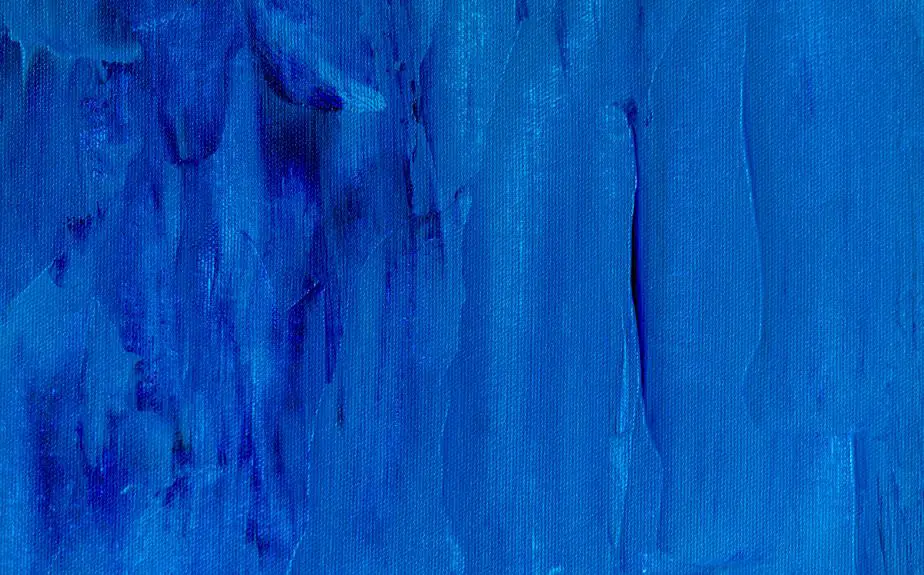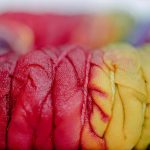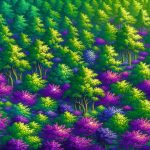When you start mixing colors for fabric painting, it's crucial to grasp the basics of color theory—how primary, secondary, and tertiary colors interact. You'll want to experiment with creating shades and tints, adjusting hues to achieve the effects you envision. Testing combinations on swatches can reveal surprising results, and documenting these findings helps refine your approach. However, the real challenge lies in mastering color harmony and knowing when to push the boundaries. Understanding these principles can elevate your work, but there's more to consider as you explore the subtleties of color mixing.
Table of Contents
Key Takeaways
- Start with primary colors, as they cannot be created by mixing and serve as the foundation for secondary and tertiary colors.
- Use test swatches to experiment with color combinations on fabric before applying them to your main project.
- Create shades by adding black to a color and tints by adding white, adjusting gradually to maintain the original hue.
- Familiarize yourself with complementary and analogous colors to enhance visual appeal and cohesion in your fabric designs.
Understanding Color Theory
To create stunning fabric paintings, you need to grasp the basics of color theory and how colors interact with one another. Understanding color relationships is crucial for achieving the desired effects in your artwork.
Start by recognizing the importance of warm and cool colors. Warm colors, like reds and yellows, evoke energy and excitement, while cool colors, such as blues and greens, create a calming effect.
Next, familiarize yourself with the concept of color harmony. Using colors that complement each other can enhance the visual appeal of your piece. You'll find that analogous colors, which sit next to each other on the color wheel, create a serene look, while complementary colors, positioned opposite one another, produce a striking contrast.
Don't forget about the impact of saturation and brightness. A highly saturated color can make a bold statement, while a desaturated color can add subtlety and depth.
Experiment with different color combinations to see how they affect the overall mood of your fabric painting. By mastering these fundamental principles, you'll have a solid foundation for mixing colors effectively, leading to more vibrant, eye-catching creations.
Primary, Secondary, and Tertiary Colors
When you start mixing colors for fabric painting, it's essential to understand the basics of the color wheel.
Primary colors form the foundation for creating secondary and tertiary colors, which can add depth to your projects.
Let's explore some mixing techniques to help you achieve the perfect shades.
Understanding Color Wheel
The color wheel is an essential tool in fabric painting, showcasing the relationships between primary, secondary, and tertiary colors. Understanding this wheel helps you mix colors effectively and create harmonious designs.
Primary colors—red, blue, and yellow—are the foundation of your palette. You can't create them by mixing other colors, but you can combine them to make secondary colors. For instance, mixing red and blue gives you purple, blue and yellow create green, and red and yellow yield orange.
Tertiary colors result from mixing a primary color with a secondary color. Examples include red-orange, yellow-green, and blue-purple. These colors add depth and variety to your fabric painting projects.
By grasping the color wheel's structure, you can better predict how colors will interact. For instance, colors opposite each other on the wheel, known as complementary colors, create striking contrasts when used together. Conversely, colors next to each other, or analogous colors, create a more serene and cohesive look.
Understanding these relationships will empower you to make informed choices while mixing colors for your fabric art, ultimately enhancing your creative expression and visual impact.
Mixing Techniques Explained
Mixing colors for fabric painting involves understanding how to blend primary, secondary, and tertiary colors to achieve the desired hues for your projects.
Primary colors—red, blue, and yellow—serve as the foundation. You can't create these colors by mixing others, but they can be combined to form secondary colors. For instance, mix red and blue to get purple, blue and yellow for green, and red and yellow for orange.
Once you've mastered primary and secondary colors, you can explore tertiary colors, which are created by mixing a primary color with a secondary color. For example, mixing blue (primary) with green (secondary) yields blue-green, also known as teal.
To achieve the perfect shade, start with small amounts of paint and gradually add more until you reach the desired color. Keep a notebook handy to document your mixes, as this helps you recreate successful combinations in the future.
Remember to test your mixed colors on a scrap piece of fabric first, as the final color may change once it dries. With practice, you'll gain confidence in mixing colors that will bring your fabric painting projects to life!
Creating Shades and Tints
To create shades and tints, you'll need to adjust the original color by adding either black or white, which alters its depth and brightness.
A shade is made by mixing in black, resulting in a darker version of your color, while a tint is created by adding white, giving you a lighter variant. This process can help you achieve the desired effect in your fabric painting.
Here are some tips to guide you:
- Start with the base color: Choose a color you want to modify, whether it's red, blue, or green.
- Add black gradually: Mix in small amounts of black to darken the color until you reach your desired shade.
- Test it out: Before applying it to your fabric, test the shade on a scrap piece to see how it looks when dry.
- Add white in increments: When creating a tint, add white little by little to avoid losing your original color completely.
Experimenting with these adjustments can bring depth and dimension to your fabric projects!
Color Harmony and Combinations
Understanding color harmony and combinations is essential for creating visually appealing fabric paintings that resonate with your audience.
When you think about color harmony, consider how different colors interact with one another. Complementary colors, like blue and orange, create a vibrant contrast that can draw attention, while analogous colors, such as blue, green, and teal, offer a soothing effect.
You can also explore triadic combinations, which involve three evenly spaced colors on the color wheel. This approach brings balance and energy to your work. For instance, using red, yellow, and blue can create a playful and dynamic effect.
Don't forget about warm and cool colors. Warm colors, like reds and yellows, can evoke feelings of warmth and excitement, while cool colors, such as blues and greens, tend to be calming.
As you mix colors for your fabric painting, keep in mind the emotions you want to convey. Experiment with different combinations to discover what resonates with you and your audience.
Ultimately, finding the right color harmony will elevate your artwork and make it more impactful.
Testing and Experimenting With Colors
Testing and experimenting with colors can lead to surprising and delightful results in your fabric painting projects.
Don't hesitate to mix and match different shades; you might discover a unique hue that elevates your artwork. Start by gathering a few essential colors and then try blending them. Here are some ideas to inspire your experimentation:
- Create a gradient: Blend colors gradually from light to dark for a stunning ombre effect.
- Use complementary colors: Pair opposites on the color wheel to create vibrant contrasts that pop.
- Try layering: Apply one color, let it dry, and then add another on top for added depth and texture.
- Incorporate unexpected colors: Experiment with unconventional combinations to see how they interact on fabric.
Tips for Fabric Painting Success
To achieve fabric painting success, it's essential to understand color wheel basics.
By familiarizing yourself with how colors interact, you can make better choices in your designs.
Also, don't forget to test swatches first to see how your colors work together on fabric!
Color Wheel Basics
The color wheel is your best friend when mixing shades for fabric painting, guiding you through harmonious combinations and vibrant contrasts. Understanding its fundamentals can elevate your projects, helping you create stunning and cohesive designs.
Here are some key color wheel concepts to keep in mind:
- Primary Colors: Red, blue, and yellow are the building blocks of all other colors. You'll mix these to form secondary colors.
- Secondary Colors: By blending primary colors, you get green, orange, and purple. These colors expand your palette significantly.
- Tertiary Colors: Mix a primary with a secondary color for shades like red-orange or blue-green, adding depth to your work.
- Complementary Colors: Opposite each other on the wheel, such as blue and orange, these colors create striking contrasts that can make your artwork pop.
Test Swatches First
Creating test swatches before diving into your fabric painting project helps you refine your color choices and techniques.
By experimenting with small samples, you can see how different colors interact with each other and the fabric. Choose a few colors you want to mix and apply them onto swatches of the same fabric you'll be using for your main project.
Don't hesitate to blend colors directly on the swatch. This allows you to see the final hue before committing to a larger area. Keep in mind that colors may appear different on fabric compared to how they look in the palette, so always test first.
Once your swatches are dry, evaluate how they look in various lighting conditions. Natural light can significantly affect how colors appear, so check them at different times of the day.
Document your findings, noting down the ratios of colors used. This way, you can replicate successful mixes easily later on.
Remember, taking the time to create test swatches not only boosts your confidence but also enhances the overall quality of your fabric painting.
Happy painting!
Frequently Asked Questions
What Tools Do I Need for Fabric Color Mixing?
You'll need a palette for mixing, brushes for application, measuring cups for precise amounts, and a spray bottle for misting. Don't forget gloves to keep your hands clean while you create vibrant colors!
Can I Mix Fabric Paint With Other Mediums?
Yes, you can mix fabric paint with other mediums like acrylics or gels, but be cautious. Each medium affects the paint's texture and adherence, so test your mixture on a small area first to ensure compatibility.
How Do I Store Mixed Colors for Later Use?
You can store mixed colors in airtight containers to prevent drying. Label them with the color and date. Keep them in a cool, dark place, and shake or stir before using them again.
What Fabrics Work Best With Mixed Colors?
When considering fabrics, you'll find natural fibers like cotton and linen absorb mixed colors beautifully. Synthetic blends can also work, but they may require special techniques to achieve the vibrant results you're aiming for.
How Do I Clean up After Mixing Colors?
After mixing colors, you'll want to clean up promptly. Wipe surfaces with a damp cloth, rinse brushes and containers thoroughly, and dispose of any excess paint properly to avoid stains and messes later.
- Tetron Fabric for Marine Applications: Durability and Use Cases - June 18, 2025
- Tetron Fabric for Outdoor Furniture: Weather Resistance and Care - June 18, 2025
- Tetron Fabric for Wall Coverings: Style and Application Tips - June 18, 2025






